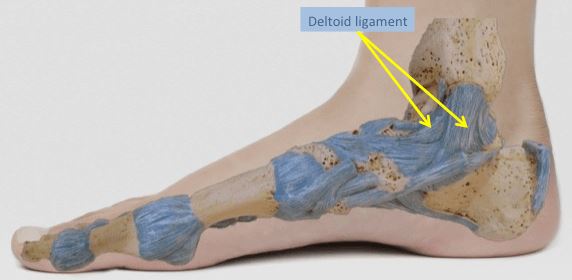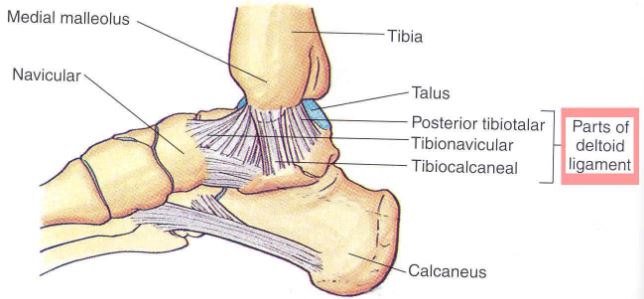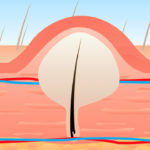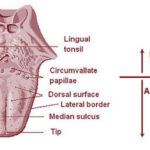Deltoid Ligament
What is Deltoid Ligament?
Deltoid ligament is a tissue, which is triangular in shape and connects the tibia to the inside of the ankle. This ligament supports your ankle and safeguards it from excess rotation to the exterior side2, 3.
There are two bones found between your ankle and knees and tibia is one of them and is the largest. It is also the strongest bone that bears weight in your body. This ligament supports the arch of your foot. Deltoid ligament is also called medial ligament.

Structure of Deltoid Ligament
Deep and superficial fibers make up the deltoid ligament. The fiber joins medial malleolus of the tibia bone to the four areas of your foot. The medial malleolus is a spherical bone that protrudes on the inside of your foot above the ankle joint. The deep fibers stretch from the medial malleolus to the surface of the talus medial surface. The superior fibers connect at three points, which are posterior, anterior and middle aspects of your talus. The talus is the bone that is situated between the foot and leg.1


Deltoid Ligament Location & Anatomy
Injuries to Deltoid Ligament (Sprain)
Since deltoid ligament is very strong, injuries and tear to this ligament are rare. Ankle sprains are common and occur as a result of excessive pressure to the ligament that joins the fibula to the talus bone. This causes the ankle joint to become torn or strained which makes your foot to twist outward.
Injuries to the ligament may also occur if you have an existing fracture in a bone found in the ankle joint or fibula which can tear deltoid ligament. This ligament can be injured when you overuse it or through general wear and tear.
People with a flat feet or knocked knees are more prone to injuring their deltoid ligament.4
Symptoms
People who have an injury to their deltoid ligament usually feel pain on the inner side of the ankle. You may also notice sudden swellings around the affected area. In case the ligament is torn, you will see some bruising there. There is also difficult in walking because you will not be able to bear the weight on the joint.
People may experience severe symptoms depending on the extend of the injury on the deltoid ligament and the type of grade. For grade 1, there is mild instability with pain, stiff joints and little swellings. While for grade 2, you will experience moderate unsteadiness, swellings, stiff joints and pains that range from moderate to severe.
Injury Grades
Injuries to the deltoid ligament can be classified into several grades. These grades include:
Grade 1
Grade one occurs when deltoid ligament is stretched and it is accompanied my mild symptoms. You may feel pain in your ankle but you will be able to bear weight on the foot.
Grade 2
Grade 2 happens when the deltoid ligament is partially torn and it is characterized by more pain as compared to grade 1. In this grade, you will not be to bear weight.
Grade 3
This is characterized by a total tear of the deltoid ligament and it is more severe.2
Diagnosis
If your doctor suspects you have an injury, some tests can be ordered to confirm if it is a fracture. The tests that can be done include X-rays to check for the fracture and other injuries to deltoid ligament2.
Ankle arthroscopy
It is a surgical method that uses a fiber optic camera and surgical tools to operate in and around the ankle joint. Your doctor chooses this procedure to assess instability of the medial, detect other pathologies such as cartilage lesions. The doctor uses this method if the patient has the following:
- There is debris in your ankle due to torn cartilage.
- If the ligament is damaged due to a sprained ankle injury.5
Treatment
A number of methods can be combined to help manage injury to the deltoid ligament. These treatment options include:
Rest
You have to rest your ankle by staying off it and avoid activities that require you to use weight. In case your ankle is very painful, use crutches so that the ankle bears little weight.
Apply ice packs
You can also apply ice packs on your ankle to reduce swelling. Ice pack can be made at home or you can purchase. Apply the ice pack on your ankle after every 10 minutes for several times a day until the swelling has reduced.
Use an elastic bandage
This kind of bandage is used to help you compress the ankle. Make sure you do not wrap your ankle so tightly because it may prevent blood flow to the leg.
Elevate the affected leg
You can also raise the affected leg above the level of your heart by lying flat on the bed while supported with three pillows below your ankle.
Use of a brace
To enhance your stability, try to use a brace to tighten or strengthen the ligament.
Surgery/ Repair
Surgery intervention may be used if all conservative methods show no improvement in the ankle or damage is severe. Your doctor may perform two types of surgery:
- The doctor may conduct surgery to tighten or re-attach the damaged ligament to the bone.
- Your doctor can also replace the damaged ligament with a nearby tendon.
After surgery, your doctor places a plaster cast on your ankle for about six weeks to boost recovery.
After this, you will also need an ankle brace for another six weeks to help tighten or strengthen the ankle.
In addition, you also need a physiotherapist to help you get back your strength and enhance ankle mobility. During this time, you will only do light exercises until six months after surgery to avoid further injury to the ligament.
Exercises
You can begin exercises with a physiotherapist when swelling and inflammation have been resolved. The physical therapy involves gentle stretching and strengthening exercises of your ankle.
Damage to the deltoid ligament may take longer to completely recover. It may take up to four months depending on the severity of deltoid damage.
Reference List
- Deltoid ligament tear. http://www.newhealthadvisor.com/Deltoid-Ligament-Tear.html
- http://mddk.com/deltoid-ligament.html
- Deltoid ligament injury, diagnosis and treatment. http://mddk.com/deltoid-ligament.html
- https://radiopaedia.org/articles/deltoid-ligament-of-the-ankle-1
- Ankle Arthroscopy. http://www.emedicinehealth.com/ankle_arthroscopy/article_em.htm






